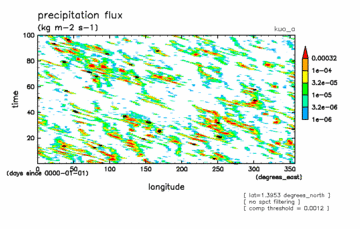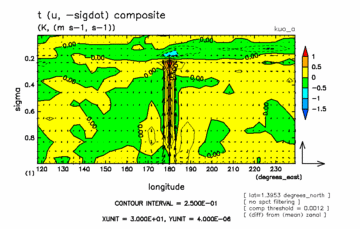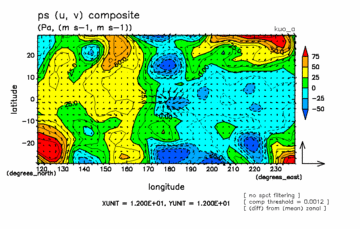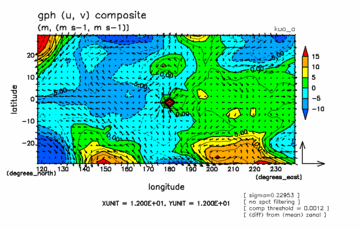| 3. Results with Kuo scheme | [prev] [index] [next] |
In either of the upper level or the lower level cooling experiment, precipitation at the equator does not occur randomly but appear as sequences of grid-scale precipitation events that propagate eastward or westward. In order to examine the relationship between the grid-scale precipitation activity and other variables, we perform composite analysis, i.e., calculate mean fields referring to the location of precipitation maximum. The procedure of the analysis follows that of Numaguti and hayashi (1991). The way of selecting locations of maximum precpitation is described in Appendix B.1.
Fig.3.10 is the composite structure referring to the eastward propagating grid-scale precpiptation of the upper level cooling experiment (kuo-c). The structure of the eastward propagating coherent disturbances described in the previous subsection is clearly shown. In the vertical section along the equator (upper right panel of Fig.3.10), we can observe a westward tilt of the structure as a whole. The westward tilt is a representative structure of a propagating unstable mode of the wave-CISK. A warm region overlaps with the region of the upward motion (key precipitation area) in the middle and the upper troposphere. The overlap between positive temperature anomaly and upward motion assures positive conversion from potential to kinetic energy.
In the horizontal sections (lower panels of Fig.3.10), we can recognize that the pressure anomaly is localized around the equator as was described in the previous subsection. The wind anomaly is dominated by the east-west component, but has some north-south component, which converges equatorward to the precipitation region in the lower and diverges poleward in the upper troposphere. It is indicated that the eastward propagating disturbances do not have a circulation structure identified as pure equatorial Kelvin wave like. This may be explained by the fact that, in addition to the effects caused by friction at the surface and nonlinearity in the upper layer, the circulation is forced by condensation heating associated with a precipitation area which is smaller than equatorial radius of deformation.
Those characteristics of the composite disturbance and its slow eastward propagation speed compared to that of the first mode of free Kelvin wave in the troposphere as observed in subsection 3.2, imply that the grid-scale precipitation structure in the upper level cooling experiment can be interpreted as the cooperative combination of precipitation activity and equatorial Kelvin wave responses. In general, this result confirms that of Numaguti and hayashi (1991) (see Appendix C. for the detailed comparison).
Fig.3.11 is the composite structure referring to the westward propagating grid-scale precpiptation of the lower level cooling experiment (kuo-a). The composite structure of the westward propagating precipitation activity differs significantly from that of the eastward propagating (Fig.3.10). In the upper left panel of Fig.3.11, the temperature anomaly is weaker and mostly localized at the location of the grid-scale precipitation. The upward motion is also weak and its area overlaps that of the grid-scale precipitation over the entire troposphere from the low altitudes to the top. No phase tilt is observed in either temperature or wind anomaly. In the horizontal sections (lower panels in Fig.3.11), the wind anomalies are shown to be much weaker and more isotropic around the precipitation event than those of the eastward propagating disturbance in upper cooling experiment.
It should be noted that the intensities of the grid-scale precipitation in the upper and lower cooling experiments do not differ greatly. This means that the reason for the significant difference between the intensities of circulation anomalies in the two experiments cannot be attributed to the difference of precipitation amounts. More probable cause can be the difference of the vertical structure of heating. In the lower level cooling experiment, the heating associated with precipitation is stronger in the lower level where the static stability of the atmosphere is stronger, while in the upper level cooling experiment, it is stronger in the upper level where the static stability is weaker. Considering the approximate balance between heating associated with precipitation and adiabatic cooling, i.e., the product of static stability and vertical motion, in the tropical atmosphere, the vertical motion in the lower cooling experiment is expected to be weaker than that in the upper cooling experiment.
Those characteristics of the composite disturbance and the rough coincidence of westward propagation speed with that of the lowlevel background zonal mean westward wind as observed in subsection 3.2, imply that the westward moving grid-scale precipitation structure can be interpreted as moist convective activity occurring at the smallest horizontal scale resolvable in the model, i.e., conditional instability of the first kind (CIFK). The westward moving convective activity is associated with the positive humidity anomaly which is advected by the mean easterly wind and is favorable for its emergence.

|

|

|

|
| Fig.3.11: The same as Fig.3.10 but for composite structure referring to the westward propagating grid-scale precipitation events for the lower-level cooling experiment with Kuo scheme (case Kuo-a). | |
| [prev] [index] [next] |